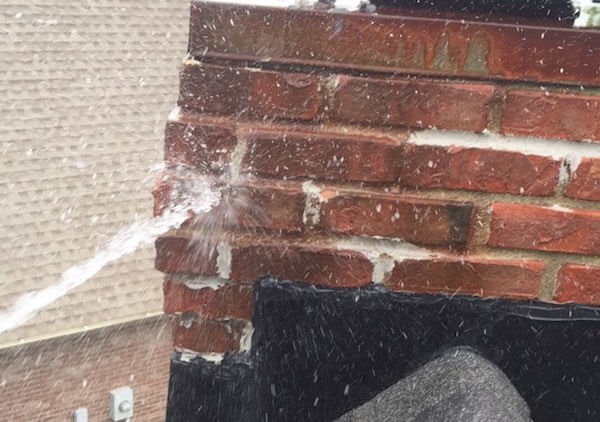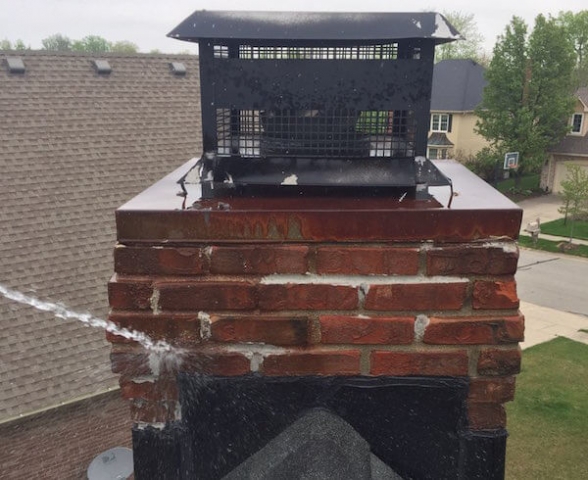Chimney Leak Assessment and Repair
Have you discovered water in your attic? Soaking the walls or ceiling of your home? Inside your fireplace? Chimney leaks can be scary, especially because it is difficult to catch the leak before it begins to affect your home. It is not always obvious where it is coming from— there are many places in your chimney and on your roof that could be the source of water penetration.
Fortunately, you are not alone. Brick + Ember Outfitters has chimney technicians and sweeps who can perform a full leak assessment to diagnose the problem and perform a chimney leak repair.
What Causes Chimney Leaks?
Leaks are not uncommon with chimneys, even when they are made of very sturdy materials. Several factors can cause water penetration — after all, chimneys are exposed to the elements, and burning wears the structure over time. The following are the most common causes of chimney leaking.
Lack of Coverage
A chimney cover is absolutely necessary for keeping water, debris, animals, and insects out of your chimney. When you do not have a cover, water gets in and blockage may occur. This is particularly dangerous if you use a fireplace; smoke stuck inside the house can cause the presence of carbon monoxide.
If you do have a cover, it may not be made of the best material or may have become cracked or loose. Original chase covers and chimney caps on older homes could be fitted incorrectly or made of metal that is rusting. To prevent rusting, stainless steel is now commonly used.
If the structure is damaged and allows water penetration, one of our technicians will be happy to help you replace it.
Chimney Crown Damage
A chimney crown seals off the top of the chimney, and it is made from concrete or mortar. Due to its vulnerable position at the top, it is exposed to rain and other elements. This could be the source of leakage.
With the variable Indiana weather, freezing and thawing in the colder months can cause constant expansion and contraction of the material. The results are small, sometimes invisible, cracks that become bigger over time.
If the cracks in the crown become big enough, a rebuilding might be necessary. Ask our chimney sweeps about getting your crown sealed with a waterproofing product.
Chimney Flashing Damage
Flashing is the metal lining, usually made of aluminum, that runs between the chimney and roof. It is a barrier to a rather large gap that would otherwise allow water in.
When it is constructed improperly, shifts due to the settling of the house, or gets damaged, it becomes a site where water can seep in. The seams and corners often become potential spots for small cracks, gaps, or lifting of the metal.
Flashing is sealed down with tar or another waterproof sealant. Tar particularly gets worn down easily. If you know your flashing is sealed with tar, talk to one of our professionals about new sealing and waterproofing options.
Brick and Mortar Wear
This is one of the most common sources. Mortar joints and other parts of the masonry are easily damaged from water problems.
Brick and mortar cracks and crumbles, allowing water to soak in. Without proper waterproofing sealant, it can even withhold this moisture and become soggy. In any case, this is dangerous to the entire structure of the chimney.
Mortar joints often have holes that water will seep into and get directed all the way inside the home. It is good to know when the last time you got your bricks waterproofed was.
Other Sources
Although not as common, your roof shingles may be damaged. If they become loose, your chimney loses coverage along with your roof, which can cause leaks and water damage throughout your house over time. If this is the case, the solution is simple — the shingles need replacement.
A switch from a wood to gas burning fireplace can also cause leaks unless you also install a chimney liner. The different types of chimneys have their own systems and mechanisms for insulation. Without a chimney liner, moisture can build up on the inside walls of a chimney with a gas fireplace.
Do You Have a Leaking Chimney?
The first step in fixing chimney leaks is making sure the water and moisture are coming from the chimney and not other places in the home. Early detection of chimney leaks is the best way to avoid costly repairs.
If you experience any of these signs, you might have a chimney leaking issue:
- Water drips into your fireplace.
- Your fireplace box has small puddles.
- There’s a stale or musty odor in the fireplace.
- The walls and ceiling surrounding the chimney have water stains.
- There are pieces of brick, mortar, and other masonry debris in the fireplace.
It’s easier to find chimney leaks in heavy rain. Searching for these signs in your home will tell you when to call a professional to prevent further damage.
Finding the Leak
If able, you can perform a test to try to pinpoint the leak. Always have someone with you to assist you in the process and to ensure one another’s safety.
Isolate areas of the chimney by placing plastic wrapping around the rest. With a hose, spray one spot for a few minutes. Do you detect any water droplets from inside your house? Move on to another spot. Complete the process from the bottom to the top of the roof and chimney.
The culprit is sometimes hard to find. This is why you may need help from one of our professional chimney technicians. We perform full leak assessments, recommend and perform a repair solution (most likely with sealant), and point out issues that may have caused the leak to begin with.
Repairs and Prevention
Proper chimney leak repair starts with a comprehensive inspection of the whole chimney structure. Our team is trained to find the source or sources of leaks and recommend a plan of action. Depending on the damage, chimney leak fixes may include:
- Replacing or placing your flashing
- Installing a chimney cap
- Sealing gaps with mortar
- Repairing or rebuilding your chimney’s crown
- Applying sealant to reinforce the chimney’s waterproofing
If there’s no damage to repair, waterproofing your chimney is a great way to get ahead of leaks. By maintaining the porous components of your chimney, you can avoid water penetration and ensure safer and more efficient winter fires.
Conducting inspections every 12 months is the best prevention for chimney leaks and other chimney issues.
A chimney should be watertight. If water is penetrating the chimney, it could lead to potential problems inside the home. You do not want to spend your cozy winter worrying about leaks or your relaxing summer dealing with chimney damage. We are here to help fix current issues and prevent future damage!
Schedule Professional Chimney Leak Repair in Indianapolis
From inspections and planned maintenance to installation and repairs, Brick + Ember Outfitters provides the chimney solutions you need. Behind every project, there’s a client entrusting us with their home, and we are committed to providing high-quality results with efficiency. With our Hassle-Free Guarantee, you can expect the best chimney experience possible.
If you are in the central Indiana area, contact Brick + Ember Outfitters today at 463-238-3568 to schedule your visit.
GET IN TOUCH
Are you ready to fix your chimney, masonry, or fireplace issues? Fill out the form below to request an appointment. One of our Outfitters will get back with you shortly.


